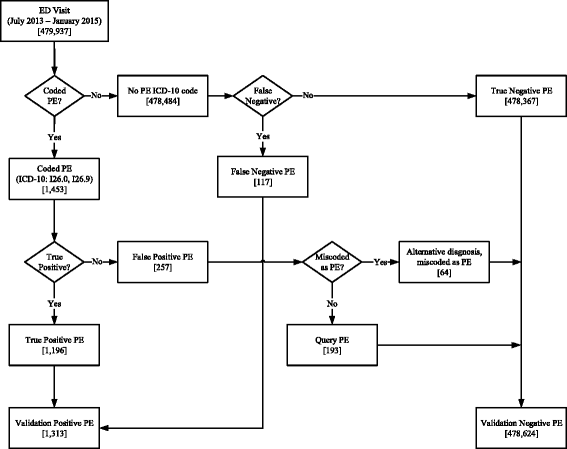Limitations of pulmonary embolism ICD-10 codes in emergency department administrative data: let the buyer beware
- PMID: 28595574
- PMCID: PMC5465555
- DOI: 10.1186/s12874-017-0361-1
Limitations of pulmonary embolism ICD-10 codes in emergency department administrative data: let the buyer beware
Abstract
Background: Administrative data is a useful tool for research and quality improvement; however, validity of research findings based on these data depends on their reliability. Diagnoses assigned by physicians are subsequently converted by nosologists to ICD-10 codes (International Statistical Classification of Diseases and Related Health Problems, 10th Revision). Several groups have reported ICD-9 coding errors in inpatient data that have implications for research, quality improvement, and policymaking, but few have assessed ICD-10 code validity in ambulatory care databases. Our objective was to evaluate pulmonary embolism (PE) ICD-10 code accuracy in our large, integrated hospital system, and the validity of using these codes for operational and health services research using ED ambulatory care databases.
Methods: Ambulatory care data for patients (age ≥ 18 years) with a PE ICD-10 code (I26.0 and I26.9) were obtained from the records of four urban EDs between July 2013 to January 2015. PE diagnoses were confirmed by reviewing medical records and imaging reports. In cases where chart diagnosis and ICD-10 code were discrepant, chart review was considered correct. Physicians' written discharge diagnoses were also searched using 'pulmonary embolism' and 'PE', and patients who were diagnosed with PE but not coded as PE were identified. Coding discrepancies were quantified and described.
Results: One thousand, four hundred and fifty-three ED patients had a PE ICD-10 code. Of these, 257 (17.7%) were false positive, with an incorrectly assigned PE code. Among the 257 false positives, 193 cases had ambiguous ED diagnoses such as 'rule out PE' or 'query PE', while 64 cases should have had non-PE codes. An additional 117 patients (8.90%) with a PE discharge diagnosis were incorrectly assigned a non-PE ICD-10 code (false negative group). The sensitivity of PE ICD-10 codes in this dataset was 91.1% (95%CI, 89.4-92.6) with a specificity of 99.9% (95%CI, 99.9-99.9). The positive and negative predictive values were 82.3% (95%CI, 80.3-84.2) and 99.9% (95%CI, 99.9-99.9), respectively.
Conclusions: Ambulatory care data, like inpatient data, are subject to coding errors. This confirms the importance of ICD-10 code validation prior to use. The largest proportion of coding errors arises from ambiguous physician documentation; therefore, physicians and data custodians must ensure that quality improvement processes are in place to promote ICD-10 coding accuracy.
Keywords: ICD-10; Miscoding; PE; Pulmonary embolism.
Figures

Similar articles
-
Improving discharge data fidelity for use in large administrative databases.Neurosurg Focus. 2014 Jun;36(6):E2. doi: 10.3171/2014.3.FOCUS1459. Neurosurg Focus. 2014. PMID: 24881634
-
Assessing the use of international classification of diseases-10th revision codes from the emergency department for the identification of acute heart failure.JACC Heart Fail. 2015 May;3(5):386-391. doi: 10.1016/j.jchf.2014.11.010. JACC Heart Fail. 2015. PMID: 25951759
-
Validating International Classification of Diseases Code 10th Revision algorithms for accurate identification of pulmonary embolism.J Thromb Haemost. 2025 Feb;23(2):556-564. doi: 10.1016/j.jtha.2024.10.013. Epub 2024 Nov 4. J Thromb Haemost. 2025. PMID: 39505153
-
Accuracy of routinely collected hospital administrative discharge data and death certificate ICD-10 diagnostic coding in progressive supranuclear palsy and corticobasal syndrome: a systematic review and validation study.J Neurol. 2024 Jun;271(6):2929-2937. doi: 10.1007/s00415-024-12280-w. Epub 2024 Apr 12. J Neurol. 2024. PMID: 38609666 Free PMC article.
-
Administrative data have high variation in validity for recording heart failure.Can J Cardiol. 2010 Oct;26(8):306-12. doi: 10.1016/s0828-282x(10)70438-4. Can J Cardiol. 2010. PMID: 20931099 Free PMC article. Review.
Cited by
-
Prevalence of Pulmonary Embolism in Patients With Syncope.JAMA Intern Med. 2018 Mar 1;178(3):356-362. doi: 10.1001/jamainternmed.2017.8175. JAMA Intern Med. 2018. PMID: 29379959 Free PMC article.
-
Evaluation of venous thromboembolism risk assessment models for hospital inpatients: the VTEAM evidence synthesis.Health Technol Assess. 2024 Apr;28(20):1-166. doi: 10.3310/AWTW6200. Health Technol Assess. 2024. PMID: 38634415 Free PMC article.
-
Bedside exclusion of pulmonary embolism in children without radiation (BEEPER): a national study of the Pediatric Emergency Care Applied Research Network-Study protocol.Res Pract Thromb Haemost. 2023 Jan 14;7(2):100046. doi: 10.1016/j.rpth.2023.100046. eCollection 2023 Feb. Res Pract Thromb Haemost. 2023. PMID: 36865906 Free PMC article.
-
Utilization of inpatient palliative care services in cardiac arrest complicating acute pulmonary embolism.Resusc Plus. 2024 Sep 14;20:100777. doi: 10.1016/j.resplu.2024.100777. eCollection 2024 Dec. Resusc Plus. 2024. PMID: 39314255 Free PMC article.
-
Accuracy of efficient data methods to determine the incidence of hospital-acquired thrombosis and major bleeding in medical and surgical inpatients: a multicentre observational cohort study in four UK hospitals.BMJ Open. 2023 Feb 6;13(2):e069244. doi: 10.1136/bmjopen-2022-069244. BMJ Open. 2023. PMID: 36746545 Free PMC article.
References
-
- World Health Organization. International Statistical Classification of Diseases and Related Health Problems 10th revision instruction manual. Geneva; 2010.
-
- Canadian Coding Standards for ICD-10-CA and CCI. [https://secure.cihi.ca/estore/productSeries.htm?pc=PCC189].
-
- Kline JA: Pulmonary embolism and deep vein thrombosis. In: Rosen's emergency medicine - concepts and clinical practice. Volume 1, 8 edn. Edited by Marx JA: Elsevier, Saunders; 2014: 1157-1169.
-
- Alberta Health and Wellness . Data disclosure handbook. 2003. pp. 1–15.
MeSH terms
LinkOut - more resources
Full Text Sources
Other Literature Sources
Medical

